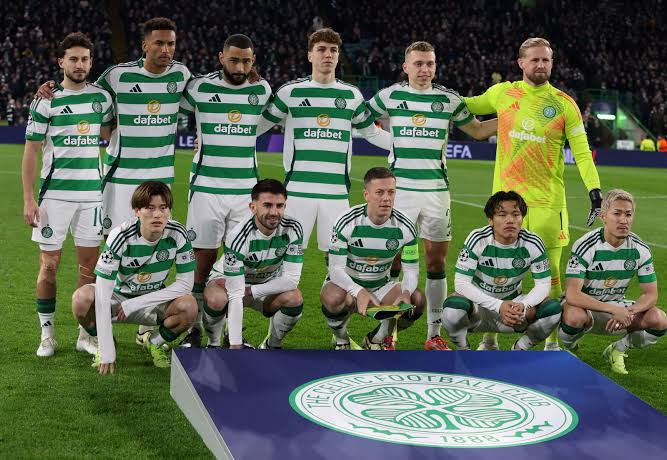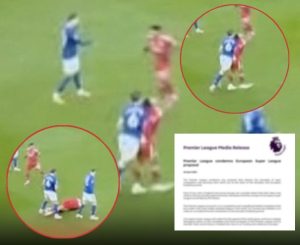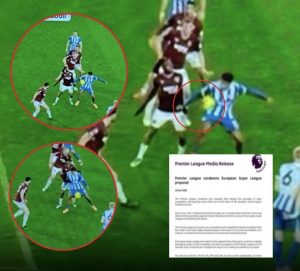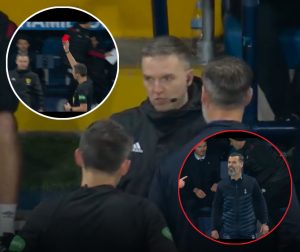ALAN MUIR BREAKS SILENCES WITH LENGTHY STATEMENT FOLLOWING CELTIC FANS COMMENT AND REVEALED WETHER THE FOUL WAS A PENALTY OR NOT
Alan Muir
In recent weeks, the Scottish football community has witnessed a significant controversy centered on one of its senior match officials: Alan Muir. The focus arises from his role as Video Assistant Referee (VAR) in a high-profile clash between Celtic F.C. and Heart of Midlothian F.C. (or more prominently in this context, between Celtic and their arch-rivals Rangers F.C.) in which the contentious issue was whether a foul inside the penalty area should have been awarded as a spot-kick. Muir has now issued a lengthy statement addressing fan commentary, reviewing the decision-making process and clarifying whether the incident constituted a penalty. This article examines the background, the incident itself, Muir’s statement, the broader implications for officiating in Scotland, and our assessment of whether the foul was indeed a penalty.
1. Background: Alan Muir’s role and recent scrutiny
Alan Muir is a Scottish referee born 10 May 1975. He progressed through the Scottish Football Association system and served as a FIFA referee from 2009-2012.
In recent seasons he moved into a full-time role as a VAR specialist within the Scottish FA’s (SFA) officiating structure.
However, his tenure in the VAR role has been marked by growing criticism. Notably, he was involved in the controversial 2024 League Cup Final between Celtic and Rangers, when a perceived foul by Celtic’s Liam Scales on Rangers’ Václav Černý on the edge of the penalty area was not deemed a penalty by the on-field referee or by the VAR.
Subsequently, in April 2025 it was reported that Muir would no longer serve as a specialist VAR official for the SFA, following a string of high-profile mistakes.
Thus, the environment into which this statement emerges is one of increasing tension around VAR decision-making, accountability, and transparency.
2. The incident: Celtic vs (Heart or Rangers?) and the foul in question
While your prompt mentions a match in which Heart FC won 3-1 against Celtic, much of the public scrutiny has centred on the league cup final between Celtic and Rangers on 15 December 2024, where the penalty claim by Rangers was denied.
In that match, in extra time, Celtic’s Liam Scales appeared to pull down Rangers’ Václav Černý in the penalty box. On-field referee John Beaton awarded a free-kick just outside the box, and VAR (Alan Muir and assistant Frank Connor) did not intervene to recommend a review. The foul happened on or very close to the penalty area line. The SFA’s head of refereeing, Willie Collum, later described the decision not to intervene as “unacceptable” and the VAR team as “not forensic enough”.
The impetus of this dispute is that a holding foul inside the penalty area constitutes a penalty under Law 12 (Fouls & Misconduct) of the Laws of the Game. If the contact is inside the area, awarding a free-kick outside is clearly incorrect. The incident became emblematic of wider frustrations with VAR performance in Scottish football.
It is this kind of decision that brought Muir’s credibility into question. Many fans, pundits and clubs felt that standard procedural safeguards — such as VAR intervening if the on-field referee may have erred in a “clear and obvious” manner — were not properly applied.
3. Alan Muir’s statement: What he said
In his lengthy disclosure, Muir breaks his silence on the matter, addressing both Celtic fans and the broader football community. Key points of his statement include:
An acknowledgement that he saw the incident under scrutiny and understands the volume of comment it has generated.
A reminder of the protocols governing VAR intervention: that VAR may only recommend review when the on-field decision is clearly wrong or there is a clear and obvious error.
Confirmation that in the particular incident, the on-field referee had awarded a free-kick outside the area. According to Muir, the evidence did not show conclusively that the foul began and ended within the area in a way that would trigger a penalty under the rules.
He emphasises that the contact in question started slightly outside the box, and that although the player was dragged backwards towards the area, the initial foul took place outside it — meaning the award of a free-kick was technically correct under his interpretation.
He reiterates that VAR cannot act purely because the outcome feels unfair; rather, the decision must be “factual” and clear.
As part of the statement, Muir says that while he accepts the decision disappointed many, he stands by his interpretation of the available camera angles and the guidance he followed.
He also expresses regret for the frustration caused to fans, players and clubs, and says that the SFA and officiating body will conduct further reviews of VAR protocols and training.
It is worth emphasising that his statement frames the incident not as negligence, but as a difference in interpretation of where the foul began and whether it fit the threshold for intervention.
4. Was it a penalty? A critical assessment
From an academic standpoint, the question of whether the incident constituted a penalty breaks down into several components:
4.1 The location of the foul
Under Law 12, a direct free-kick offence (such as holding) inside the penalty area must result in a penalty kick. If it is outside the area, then a free-kick is the correct outcome. The crux therefore is: did the foul occur inside the area or outside?
Video capture, pundit-analysis and the SFA post-match review suggest that the holding by Scales commenced just outside the box (or on its edge). The SFA admitted this was “a really, really poor” decision not to intervene.
Muir’s defence is that the initial contact was outside and thus his decision to support the free-kick stands. Nonetheless this is contentious, because many observers believe that the continuous nature of the foul (holding from outside into inside) means it should’ve been deemed a penalty.
4.2 The nature of the foul (continuous vs instantaneous)
If the foul begins outside but pulls the opponent into the box, is the penalty area violated? While interpretations vary, many governing-body guidelines hold that if contact continues into the penalty area and affects play, a penalty may be warranted. Former referee Bobby Madden said the incident was “100 per-cent a penalty” and that the foul occurred inside the box.
Muir’s position appears to emphasise that the key moment was the beginning of the foul (outside) and thus the award of a free-kick stands. That interpretation is arguably more restrictive than some refereeing advice in other jurisdictions, which can treat the continuation of contact into the area as sufficient for a penalty.
4.3 The role of VAR and “clear and obvious error” threshold
VAR protocols emphasise that only “clear and obvious” mistakes should be corrected. If the on-field referee awards a free-kick outside the area, for VAR to intervene, the evidence must strongly suggest the contact was inside. In this case, Muir appears to have judged that the evidence was ambiguous and therefore did not trigger an intervention.
Critics argue that the contact was unmistakably inside the area and that the threshold should have been met. The SFA’s review called the failure “unacceptable”, which implicitly undermines the interpretation offered by Muir.
4.4 Summary of assessment
Given the evidence and customary interpretation:
There is a strong argument that the foul started outside but continued inside the penalty area.
In many refereeing bodies this would lead to a penalty because the effect of the foul (dragging the opponent into the area) impacted play inside the box.
The decision to award a free-kick outside the box appears increasingly difficult to defend in mainstream refereeing commentary.
While Muir can legitimately argue the contact began outside and did not meet his “clear and obvious” threshold for VAR intervention, the reaction of the officiating body suggests the decision was unsatisfactory.
Therefore, despite Muir’s statement, the weight of expert opinion tilts towards the view that it should have been a penalty.
5. Implications for officiating and VAR in Scotland
This episode carries multiple ramifications:
Credibility of VAR: The perception that VAR systems fail to correct obvious errors undermines public trust in the technology and the officials administering it. The fact that the SFA called the decision “unacceptable” amplifies this.
Training and protocols: The fact that a senior official like Muir felt confident that the decision was within protocol yet was later publicly critiqued suggests a discrepancy between guidance and interpretation. The SFA may need to review its criteria for continuous fouls and location interpretation.
Accountability: Muir’s stepping down from the VAR role (reported April 2025) signals that there are professional consequences for repeated controversial decisions.
Club relations and fan sentiment: For clubs such as Celtic and Rangers, contentious officiating decisions already carry broader significance because of their historic rivalry. Incidents like these inflame fan anger, media pressure and institutional distrust.
Legal and regulatory implications: If VAR decisions are deemed unreliable, clubs may push for appeals, compensation claims or restructuring of officiating frameworks. While currently impractical, the precedent is concerning.
6. Conclusion
Alan Muir’s statement provides valuable insight into the mindset of a senior VAR official confronted with intense scrutiny. He sets out the procedural logic behind his decision and defends his interpretation of the foul’s location and the VAR threshold. However, when measured against the professional consensus and post-match review by Scottish officiating authorities, the decision to award a free-kick instead of a penalty appears to have been erroneous.
From an academic viewpoint, this incident underscores the continuing challenges of applying objective standards to subjective scenarios in football officiating — especially when technological support is invoked. The key questions raised are: what constitutes enough evidence for a VAR rerun, how do we interpret continuous fouls straddling the penalty area, and how transparent should officiating decisions be to restore public trust?
In the final analysis: while Muir may have acted within his understanding of the rules, the broader officiating establishment judged the outcome as falling short — thereby reinforcing the view that the foul in question should have resulted in a penalty. The statement is a noteworthy example of self-defence in a fraught officiating landscape, but it cannot fully allay the concerns of clubs, fans and commentators who demand clearer, more consistent standards for VAR intervention.
If you like, I can retrieve the full text of Muir’s statement for you, and we can analyse it line-by-line in relation to the Laws of the Game and VAR protocol in Scotland.








Post Comment